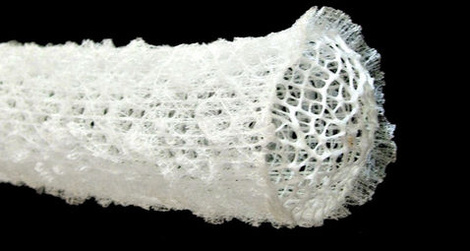Interesting, non? This is causing a bit of excitement but before first, here’s more from the Sept. 14, 2017 American Association for the Advancement of Science (AAAS) news release on EurekAlert,
Cotton that’s grown with molecules that endow appealing properties – like fluorescence or magnetism – may one day eliminate the need for applying chemical treatments to fabrics to achieve such qualities, a new study suggests. Applying synthetic polymers to fabrics can result in a range of appealing properties, but anything added to a fabric can get washed or worn away. Furthermore, while many fibers used in fabrics are synthetic (e.g., polyester), some consumers prefer natural fibers to avoid issues related to sensation, skin irritation, smoothness, and weight. Here, Filipe Natalio and colleagues created cotton fibers that incorporate composites with fluorescent and magnetic properties. They synthesized glucose derivatives that deliver the desirable molecules into the growing ovules of the cotton plant, Gossypium hirsutum. Thus, the molecules are embedded into the cotton fibers themselves, rather than added in the form of a chemical treatment. The resulting fibers exhibited fluorescent or magnetic properties, respectively, although they were weaker than raw fibers lacking the embedded composites, the authors report. They propose that similar techniques could be expanded to other biological systems such as bacteria, bamboo, silk, and flax – essentially opening a new era of “material farming.”
Robert Service’s Sept. 14, 2017 article for Science explores the potential of growing cotton with new properties (Note: A link has been removed),
You may have heard about smartphones and smart homes. But scientists are also designing smart clothes, textiles that can harvest energy, light up, detect pollution, and even communicate with the internet. The problem? Even when they work, these often chemically treated fabrics wear out rapidly over time. Now, researchers have figured out a way to “grow” some of these functions directly into cotton fibers. If the work holds, it could lead to stronger, lighter, and brighter textiles that don’t wear out.
Yet, as the new paper went to press today in Science, editors at the journal were made aware of mistakes in a figure in the supplemental material that prompted them to issue an Editorial Expression of Concern, at least until they receive clarification from the authors. Filipe Natalio, lead author and chemist at the Weizmann Institute of Science in Rehovot, Israel, says the mistakes were errors in the names of pigments used in control experiments, which he is working with the editors to fix.
That hasn’t dampened enthusiasm for the work. “I like this paper a lot,” says Michael Strano, a chemical engineer at the Massachusetts Institute of Technology in Cambridge. The study, he says, lays out a new way to add new functions into plants without changing their genes through genetic engineering. Those approaches face steep regulatory hurdles for widespread use. “Assuming the methods claimed are correct, that’s a big advantage,” Strano says.
…
Sam Lemonick’s Sept. 14, 2017 article for forbes.com describes how the researchers introduced new properties (in this case, glowing colours) into the cotton plants,
…
His [Filipe Natalio] team of researchers in Israel, Germany, and Austria used sugar molecules to sneak new properties into cotton. Like a Trojan horse, Natalio says. They tested the method by tagging glucose with a fluorescent dye molecule that glows green when hit with the right kind of light.
They bathed cotton ovules—the part of the plant that makes the fibers—in the glucose. And just like flowers suck up dyed water in grade school experiments, the ovules absorbed the sugar solution and piped the tagged glucose molecules to their cells. As the fibers grew, they took on a yellowish tinge—and glowed bright green under ultraviolet light.
Glowing cotton wasn’t enough for Natalio. It took his group about six months to be sure they were actually delivering the fluorescent protein into the cotton cells and not just coating the fibers in it. Once they were certain, they decided to push the envelope with something very unnatural: magnets.
This time, Natalio’s team modified glucose with the rare earth metal dysprosium, making a molecule that acts like a magnet. And just like they did with the dye, the researchers fed it to cotton ovules and ended up with fibers with magnetic properties.
…
Both Service and Lemonwick note that the editor of the journal Science (where the research paper was published) Jeremy Berg has written an expression of editorial concern as of Sept. 14, 2017,
In the 15 September [2017] issue, Science published the Report “Biological fabrication of cellulose fibers with tailored properties” by F. Natalio et al. (1). After the issue went to press, we became aware of errors in the labeling and/or identification of the pigments used for the control experiments detailed in figs. S1 and S2 of the supplementary materials. Science is publishing this Editorial Expression of Concern to alert our readers to this information as we await full explanation and clarification from the authors.
The problem seems to be one of terminology (from the Lemonwick article),
… Filipe Natalio, lead author and chemist at the Weizmann Institute of Science in Rehovot, Israel, says the mistakes were errors in the names of pigments used in control experiments, which he is working with the editors to fix.
…
These things happen. Terminology and spelling aren’t always the same from one country to the next and it can result in confusion. I’m glad to see the discussion is being held openly.
Here’s a link to and a citation for the paper,
Biological fabrication of cellulose fibers with tailored properties by Filipe Natalio, Regina Fuchs, Sidney R. Cohen, Gregory Leitus, Gerhard Fritz-Popovski, Oskar Paris, Michael Kappl, Hans-Jürgen Butt. Science 15 Sep 2017: Vol. 357, Issue 6356, pp. 1118-1122 DOI: 10.1126/science.aan5830
This paper is behind a paywall.
